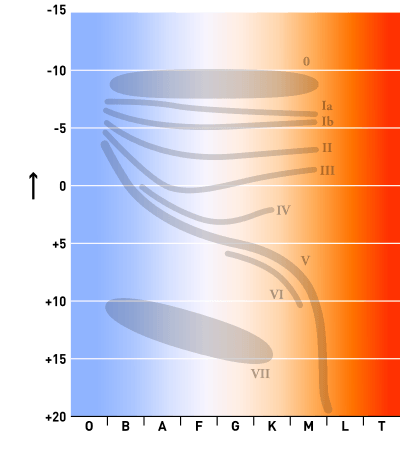K-type main-sequence star facts for kids
A K-type main-sequence star is often called a K dwarf or an orange dwarf. It's a type of star that's burning hydrogen in its core, just like our Sun. These stars are a bit smaller and cooler than our Sun, but bigger and hotter than the smallest stars, called red dwarfs.
K-type stars have a mass between half and 0.8 times the mass of our Sun. Their surface temperatures are usually between 3,900 and 5,200 K. Scientists are very interested in K-type stars because they might be great places to look for life beyond Earth. Some well-known examples are Alpha Centauri B and Epsilon Indi.
Why K-Type Stars Are Great for Life
Scientists think K-type stars are especially interesting when searching for extraterrestrial life. Here's why:
- Long Lifespan: K-type stars live for a very, very long time – from 18 to 34 billion years! Our Sun, a G-type star, will only live for about 10 billion years. This super long lifespan gives life plenty of time to start and grow on any planets orbiting these stars.
- Less Harmful Radiation: K-type stars give off less ultraviolet radiation than stars like our Sun. Ultraviolet light can damage DNA, which is the building block of life. So, less of it means a safer environment for life to develop.
- Common in the Universe: K-type stars are about three to four times more common than G-type stars (like our Sun). This means there are many more of them out there to explore, making it easier to find planets around them.
- Better Than Red Dwarfs: While M-type stars are even more common, they have some downsides. Planets orbiting M-type stars are more likely to be "tidally locked," meaning one side always faces the star, making temperatures extreme. M-type stars also have more powerful solar flares that could harm nearby planets. K-type stars are a good middle ground.
- Wide Habitable Zone: The "habitable zone" is the area around a star where it's not too hot and not too cold for liquid water to exist on a planet's surface. K-type stars have a wider habitable zone than M-type stars, giving planets more room to orbit comfortably.
Because of all these reasons, K-type stars might be the best places to look for exoplanets (planets outside our solar system) and signs of life.
Some K-type stars close to us that are known to have planets include Epsilon Eridani, HD 192310, Gliese 86, and 54 Piscium.
Images for kids
-
61 Cygni, a binary K-type star system.
See also
 In Spanish: Enana naranja para niños
In Spanish: Enana naranja para niños



